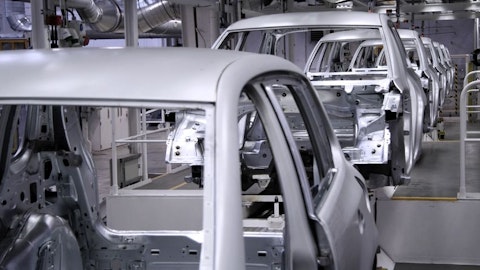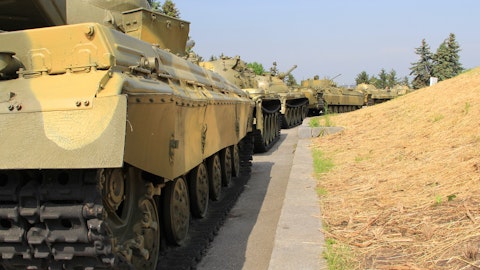John Pfeifer: Yeah. This is a segment that, first of all, we like businesses, the businesses that we have that — where we can deploy technology and continue to expand our business like the Volterra electric fire truck. That will be a growth platform for many years, that product. But we also do look at this as a fruitful M&A opportunity. When you look at what we do and what we know how to do, purpose built Vocational product. When I say purpose built, I’m talking about we design and develop the entire vehicle from ground up to survey purpose for an end market. So when we look at that, we do see opportunity. There will be inorganic opportunity. It’s a little bit hard to predict the timing on inorganic opportunity, but that’s certainly part of what we want to do is continue to grow this segment beyond the current organic position that we have. But we like the organic position that we have. We expect the organic position alone to get to $3 billion without any M&A, so.
Mig Dobre: Okay. Appreciate it.
Pat Davidson: Thanks, Mig.
Operator: Our next question comes from the line of Tami Zakaria with JPMorgan. Please proceed with your question.
Tami Zakaria: Hi. Good morning. Thank you so much. I have a couple of quick questions for you. So the first one is, can you comment on the margin profile of the Rear Discharge Concrete Mixer business that you’re exiting, I think you mentioned about $150 million in sales, but I didn’t catch the margin profile of that business.
Mike Pack: Tami, it’s very low-single digit.
Tami Zakaria: Got it. And the $0.30 new product development investment headwind this year, should we think about that completely reversing in 2024 or should that stay in the base for the next couple of years, but then it kind of reverses. So how should we think about that?
Mike Pack: Hey, Tami. I think if you think about what we talked about at Analyst Day, I would expect that we continue to have strong investments over the next few years. So I think that would be representative of over the next few years.
Tami Zakaria: Got it. Can I squeeze in one last one. Can you provide some quantification on the cost synergies you expect by combining the F&E and Commercial segments?
Mike Pack: Yeah. We’re not providing quantification yet because, particularly this year, with the transition services agreement, there’s going to be a bit of a delay over the next several months and being able to act up on those. But we do expect them over time. And certainly, we’ll provide updates as we go.
Tami Zakaria: Got it. Thank you so much.
Operator: Our next question comes from the line of Stanley Elliott with Stifel. Please proceed with your question.
Stanley Elliott: Hey. Good morning, everyone. Thank you all for taking the question. A quick question on the new Vocational group with the waste collection vehicles and then also with the fire vehicles. How aggressive do you see those end markets moving to pursue more of an EV sort of, or battery electric vehicle offering that you guys have been testing in the marketplace currently?
John Pfeifer: Yeah. It depends on the end market, Stanley, but let’s take the Volterra electric municipal fire truck. You could even take the Volterra airport rescue and firefighting vehicle. Now we go in — we release this for sale and go into production in 2024. So when we talk about units going to Portland, Oregon and the unit in Madison, Wisconsin and a few other places, these are really call them beta test units. There are municipalities that want to be partners in development, and that’s going extremely well. But the amount of interest that we are getting from municipalities across the country is really, really strong. And it can be — of course, it’s a little bit regional. So think about the State of California. The state of California, I think we’ll be probably one of the leaders in terms of pull rate on this product because as of their interest in electrifying faster than other regions.
But I think this is going to go across the country. We’ve seen — it’s not just California. We’ve seen a lot of interest from all over the country from every single one of our dealers. So this will be a really nice long-term growth product. Now you get into other end markets that we’re in, and it could be even faster than that. So this is one of the reasons we are so bullish on this new segment.
Stanley Elliott: Great guys. That’s it for me. Thank you.
Operator: Our next question comes from the line of Seth Weber with Wells Fargo. Please proceed with your question.
Seth Weber: Hey, guys. Good morning. I apologies if I missed this, but I wanted to better understand the Access margin guidance for this year. If you guys are going to be doing $4.2 billion of revenue, and it sounds like price cost is neutral to positive. Your 11% margin is below what you guys did in 2019 or it’s about on par with what you did in 2018 at lower revenue. So I’m just trying to understand what’s changed here and why margins aren’t better with the higher revenue? Thanks.
Mike Pack: Sure. It’s really two things, Seth. Number one, obviously, we talked about price cost that I would say that because of the supply chain environment, the impact on manufacturing is still significant. So we’re seeing much higher manufacturing inefficiencies than we would have seen in those previous periods, which as supply chain normalizes, that will improve. And again, even though the volumes lower from a throughput perspective, there’s fewer units. So that obviously has a bit of an absorption impact as well that sort of plays into that. So I think that’s really probably the biggest thing.
Seth Weber: Okay. But it’s fair to say that your price cost neutral to positive for 2023 and Access, sounds good.





